Ibiza
![]()
This article is about the island of Ibiza. For the city of the same name, see Ibiza (city); for a car model, see Seat Ibiza. See also Ibiza affair.
Ibiza (Spanish [iˈβiθa], Catalan and officially Eivissa [əjˈvisə] or [əjˈbisə]) is the third largest island in the Spanish autonomous region of the Balearic Islands in the western Mediterranean Sea, with an area of 572 km².
Together with the island of Formentera to the south and numerous smaller and uninhabited rocky islands, Ibiza forms the archipelago of the Pitiusas. Official languages are Spanish (Castilian) and Catalan, the Catalan dialect predominant on the island is called Ibizenk. The island has 147,914 inhabitants (as of 2019), the proportion of foreigners is about 20 percent, the proportion of German residents is about 3 percent. Since 2001, the number of people living permanently on Ibiza has increased by more than 60 percent. The largest municipalities are the main town of Ibiza (Eivissa in Catalan) with about 50,000 inhabitants, Santa Eulària des Riu (about 36,000 inhabitants), Sant Josep de sa Talaia (about 26,000 inhabitants) and Sant Antoni de Portmany (about 25,000 inhabitants).
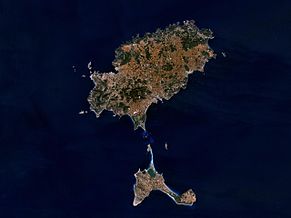
Satellite image of Ibiza (top) and Formentera (bottom)
Geography
Location
The island is located about 90 kilometres east of the Spanish mainland. The distance San Antonio - Dénia is 111 km, Ibiza - Denia 146 km, Ibiza - Palma de Mallorca 154 km. The distance to Alicante is about 200 km, San Antonio - Valencia 150 km, Ibiza - Barcelona 264 km and to Algiers 276 km.
Geology
The Balearic Islands are the blasted continuation of the Andalusian rocky mountains that stretch from Gibraltar across the Sierra Nevada. A trench about 1,500 meters deep separates the islands from the Spanish mainland. The Pitiusas have their own continental shelf.
Description
Ibiza is an inland hilly island with a rugged coastline punctuated by sandy calas. The length of the coast is about 210 kilometres. Ibiza's highest elevation is Sa Talaia at 476 msnm.
The biodiversity and culture of Ibiza was declared a World Heritage Site in 1999.
fauna and flora
Apart from the many well-known beaches and coves, the island of Ibiza has an almost completely unknown wealth of fauna and flora.
The island can be roughly divided into four landscape zones: The north or steep coast, forests and garigue, cultivated land and farmland, beaches and bays.
The north coast, es amunts, the hills, are largely protected. The area stretches from the plateau at Santa Agnès de Corona to the north-eastern tip of the island to Punta Grossa near Cala San Vicente. This region is sparsely populated, there are hardly any towns and only a few accessible bays or beaches and therefore almost no tourism.
In the vast evergreen pine forests and in the garigue, these landscapes often interspersed with juniper bushes, rosemary, thyme and other wild herbs, also grow, among others, the rare holm oak, autochthonous orchids and wild gladioli. It is also the retreat of the genet, which has become very rare.
On the coasts, beaches and coves, and in the wetlands such as Ses Salines, the water basins for salt extraction, and Ses Feixes, the two allotment zones around the town of Ibiza, probably created by the Moors in the 11th century, which are part of the Unesco World Natural Heritage, grow plants that are particularly resistant to salt water. These wetlands are also the breeding grounds of numerous aquatic birds. A colony of flamingos now lives year-round in the old salt ponds of Ses Salines. Kestrels (more rarely Eleonora's falcons), ospreys and many other species of birds such as gulls (laughing gulls, herring gulls, storm-petrels and more rarely the coral gull). Swallows, herons (night heron, great egret, little egret), cormorants and black-winged stilts also live in these zones.
The cultivated and agricultural land of the island of Ibiza is characterised mainly by a form of three-field farming known since the Middle Ages. These fields are usually planted with wheat (trigo), barley (cebada) or oats (avena). Typically, almond, olive, carob and fig trees were cultivated at loose intervals in between. The edges of the fields, often terraced and traditionally enclosed with dry stone walls, are planted with wild plants and vines for farm wine (vi payes). Corn poppies, margarites (Chrysanthemum coronarium), sharp sheaves, wild fennel (Foeniculum vulgare) and wild asparagus or rock roses. Kites, barn owls and lesser scops owls or hoopoes live here. Also goldfinches, finches, thrushes, velvet-headed warblers or tits, curlews and turtle doves.
In areas with groundwater resources or deep wells, such as near San Antonio, fruits and vegetables are planted. Here especially melons, tomatoes, grapes, citrus fruits, but also legumes such as beans, lentils or peas. In the area around Santa Gertrudis, which is considered as fertile as the great plain in front of San Miguel, fruit trees grow with cherries, peaches, apricots, mangos or avocados. The valley of San Mateo is known for its viticulture. In addition to the dog breed Podenco Ibicenco (Ca Eivissenc in Catalan), the most conspicuous animal on the island, Ibiza has a number of other autochthonous animals. For example, the peasant chicken Pollo payes, the Oveja ibicenca, the Ibizan sheep, a wild rabbit and the Pityus lizard (Podarcis pityusensis pityusensis).
Threat to fauna and flora
Unknown until a few years ago were any kind of snakes or other poisonous animals. Only in the course of the import of olive trees for squares and gardens, vipers (horseshoe snakes and step snakes) were introduced, which are now spreading but are also already hunted by the island government, because they decimate small game and here especially rabbits and lizards and bird clutches.
Since around 2005, palm trees, mostly the Canary Island date palm, have been decimated by the palm weevil on Ibiza. Although the island government insists that plants infested by the insect are immediately sprayed with insecticides or destroyed, the infestation continues to spread. Meanwhile, other plants such as fan palm, dwarf palm and palm lilies are also being infested. The damaged palms slowly die from the core. This is visible when the fresh palm fronds in the centre of the palm turn brown and droop.
Since 2016/17, the fire bacterium has been discovered in the Balearic Islands, especially in Mallorca, but also in Menorca and Ibiza. This bacterium also attacks fruit trees such as olive and almond trees or vines. The external characteristic is the partial withering of the plant. Since there is no suitable antidote so far, the EU obliges as an immediate measure to cut down and burn all trees and all others within a radius of 100 meters from the infested plant. Investigations of the bacterium have shown that it is the aggressive form Xylella fastidiosa pauca, which, in addition to the trees already mentioned above, can also infect cherry trees, laurel bushes, willow-leaf acacias, lavender, rosemary, oleander, Australian rosemary (Westringia fruticosa) and crucifers.
Another threat to the island's flora is the large forest gardener (Tomicus piniperda and Tomicus destruens), which has become more common in recent years. Thus, one is surprised to suddenly find completely brown, withered pine trees in a patch of forest. This is a beetle from the bark beetle family, which attaches itself to the trunk of the pine tree and deposits its brood in the bark, this leads to the death of the tree in a short time.
The processionary moth plague, which is widespread throughout the Balearic Islands, has been relatively well contained in Ibiza in recent years. For many years, the spread of the moth has been reduced and prevented in various regions of the island through the use of pheromones. This can be recognised by the white plastic cups with the pheromone that are fixed in the pine trees. In the meantime, Bacillus thuringiensis is also used for control.
A new occurrence around 2019/20 is also the infestation of cacti (Opuntia ficus-indica) by the cochineal scale insect. The shrub-like formations of the plant are covered with white spots and after some time the rotten leaves fall off. However, after a time the plant can regenerate itself.
The Picudo negro appeared for the first time in 2019/20. A black beetle from the Rhynchophorus family that threatens the agaves. The beetle bores into the heart of the agave and lays its eggs there. The maggots feed on the soft plant parts inside the plant. Apparently, another bacteria is released in the process. The plant dies completely in a short time. The beetle also attacks yuccas and dragon trees.
Climate
Ibiza has the most balanced climate of the Balearic Islands. Average temperatures are around 26°C in summer and reach a very mild 12°C in winter.
| Ibiza/Eivissa (1981-2010, Ibiza Airport Station) | ||||||||||||||||||||||||||||||||||||||||||||||||
| Climate diagram | ||||||||||||||||||||||||||||||||||||||||||||||||
| ||||||||||||||||||||||||||||||||||||||||||||||||
| Monthly average temperatures and precipitation for Ibiza/Eivissa (1981-2010, Ibiza Airport station)
Source: Valores climatológicos normales: Eivissa, Aeropuerto, 1981-2010 (AEMet); wetterkontor.de (water temperature) | |||||||||||||||||||||||||||||||||||||||||||||||||||||||||||||||||||||||||||||||||||||||||||||||||||||||||||||||||||||||||||||||||||||||||||||||||||||||||||||||||||||||||||||||||||||||||||||||||||||||||||||||||||||||||||||||||||||||||||||||||||||||||||||||||||||||||||||||||||||||||||||||||||||||||
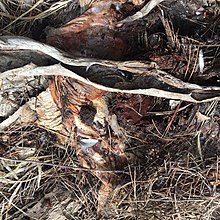
Rhynchophorus palmarum
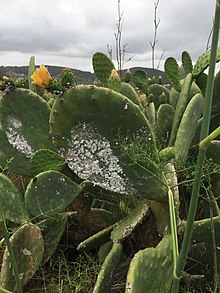
Infestation of a cactus bush by cochineal scale insects
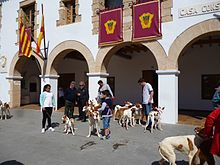
Podenco show on 1 May 2016 in Santa Eulalia
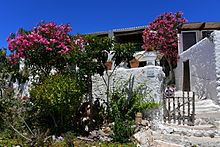
400 year old country house in the hinterland
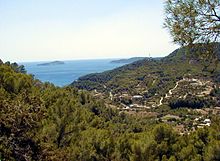
Bay of Sant Vicent. Pine forests, mountains, the sea and widely scattered fincas characterize the image of Ibiza.
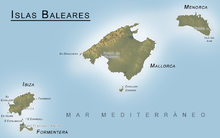
Location of Ibiza within the Balearic Islands
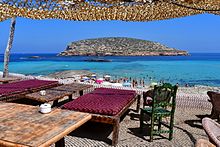
Platja de Comte
Culture
Museums
Ibiza has various cultural facilities, such as museums, information centres on island life and event venues.
- In the old town of Ibiza, a UNESCO World Heritage Site, with its fortified walls that were renovated and extended in 1555, an open-air museum can be visited on the western flank. Here you can see how they protected themselves against enemies and defended the fortress.
- At the highest point of the old town, in Dalt Vila, stands the 14th century cathedral. The main altar is dedicated to Maria de las Nieves (Mary of the Snows). The cathedral houses the Museo Diocesa, the museum of the diocese.
- The Museo Arqueológico de Ibiza y Formentera is located in the Plaça de la Catedral.
- Right next door is the Centro de Interpretation Medina Yabisa (C/ Major, 2 Edificio La Cúria). A multimedia show and various models depict life at the time of the Moors.
- Just before leaving the old town fortress and in the immediate vicinity of the drawbridge and Portal de ses Taules, is the Museo d'Art Contemporani d'Eivissa (MACE). This museum of contemporary art houses a collection of artists living or formerly living in Ibiza in one of the oldest buildings still standing in the old town of Ibiza. Various works by the international artists' group Grupo Ibiza 59 are also on display. The museum also hosts temporary exhibitions by renowned artists such as Joan Miró and Cy Twombly. Some time ago, during expansion work, the foundations of a house from Roman times and various artefacts were uncovered, which can be seen under walk-through glass panels. (Location: Ronda Narcis Putget).
- Another archaeological museum is located at the necropolis of Ibiza, on Puig des Molins (entrance: Vía Romana, 31). Here you can visit some underground tombs; and in the newly designed museum, some objects from the Phoenician and Roman eras are on display.
- Remains of one of the earliest Phoenician settlements in the western Mediterranean can be seen in the Yacimiento fenicio de Sa Caleta (part of Sant Josep, on the south coast). This part, like other areas, is also part of the island's UNESCO World Heritage Site.
Theatre and music
- In the capital, Ibiza, Can Ventosa is used as a concert and theatre venue (Avinguda d'Ignasi Wallis, 26).
- In Santa Eulalia you can use the Congress Centre (Palacio de Congresos de Ibiza, Avenida Salvador Camacho 9-11). Here you can see concerts by Jordi Savall or opera and dance performances.
- The Good Friday procession leads from the cathedral through the narrow streets of the old town to the lower town. In the passage of the Torre de ses Taules you can sometimes hear a saeta, a spontaneous supplication similar to flamenco.
- During the patron saint festivals, the island's folklore groups perform their dances in original costumes to music accompanied on the one-handed flute with drum and especially large castanets.
- At Christmas and Easter, the Caramelles are performed in some village churches. These are the Christmas or Easter stories that are recited with the island's typical music and in the Redoblar singing style.
Architecture
The church, which was not elevated to cathedral status until 1782, was completed in the 14th century. It stands on the highest point of the listed old town (Dalt Vila) and is surrounded by the Renaissance fortress, which was already built in the second half of the 16th century. As early as the 1930s, a number of intellectuals such as Walter Benjamin, Wols, Raoul Hausmann, Walter Gropius and Le Corbusier came to Ibiza. All of them recognised the special feature of the mostly single-storey construction of the old farmhouses on the island and reported on it. The juxtaposed cubes of these country houses also inspired Bauhaus architecture. Apart from the stone walls, which are almost one metre thick, the arrangement of the rooms is striking. The entrance almost always faces south. One enters the Finca Ibicenca via a kind of veranda (porxo), from which one side leads to the kitchen. Attached to this is a bread oven, nearby a cistern for drinking water. Adjacent to the kitchen is the storeroom. From the porxo there are several bedrooms. The houses have exclusively flat roofs to collect the rainwater, which is collected in cisterns. The windows are very small, so the rooms are cool in summer. The German emigrant Erwin Broner, who lived in Ibiza for many years, studied the island's architecture extensively and modernised some old farmhouses. In later years, the Canadian Rolph Blakstad studied the island architecture in detail and built in the Neo-Ibizan style. The Belgian architect Philippe Rotthier, who lives in Ibiza, has written the most detailed publication on the architecture of Ibiza's country houses.
Kitchen
The original cuisine of Ibiza is purely rural. Now, because of the many tourists from all over the world, there are many restaurants with international or modern Catalan cuisine scattered all over the island. Restaurants in the larger towns and country inns compete with beach restaurants for wealthy individual travellers in the summer months. Paella, the Spanish national dish, actually a leftover meal, comes in many varieties. The best known are the Mixta with chicken, pork or rabbit meat, some fish, some shrimps and mussels and the Mariscos, only with seafood. The original paella gets its yellow color from saffron. There are the traditional fish dishes Bullit de Peix and Arroz a la Banda, as well as the Frità de Pulpo, a tapa of squid with some potatoes, peppers, onions and garlic. Lamb dishes (lamb chops, skewers, leg of lamb) and the red pepper sausage sobresada or the dark and light blood sausage butifarra are also common. Alioli is a typical island aioli, made only of garlic with olive oil and salt. Desserts include Crema Catalana and Fláo, a cheesecake made from goat's and sheep's milk with aniseed and hierbabuena (green mint).
Sports
In addition to the more usual sports, such as hiking, running, swimming, horseback riding, tennis or golf, the following sports are also suitable in Ibiza:
- Diving - there are about ten dive centres, all of which can be found either in the larger towns, in the tourist centres or on the larger beaches. The official website of the island's government Deportes De Ibiza has a PDF list of 20 diving tours with photos, maps and levels of difficulty. Due to the seagrass beds of Posidonia Oceanica, the water is usually very clear. The fish variety and density is rather low. Mainly sea junker (Coris julis), writing perch (Serranus scriba), thick-lipped mullet (Chelon labrosus), golden sarpa (Sarpa salpa), sea peacock (Thalassa pavo) can be seen, sometimes also starfish, squid, the noble pinna (Pinna nobilis) or the Mediterranean moray eel (Muraena Helena). In certain years, the luminescent jellyfish (Pelagia noctiluca) can be unpleasant, as their stinging nettles can cause painful stings on bare skin.
- Kayak - again on the Deportes De Ibiza page, another PDF list with photos, maps, start and finish, distance and approximate duration lists 20 kayak tours.
- Sailing, windsurfing, stand up paddling. Here too, equipment can be rented and lessons taken in some towns, tourist centres and on some beaches.
- There is a harness racing track (Hipodromo de Sant Rafal)
- In recent years, Ibiza has also seen an increase in the number of half-marathons, track races and mountain bike races.

enlarge and show information about the picture
![]()
Cala d'Hort in Ibiza with views of Es Vedra
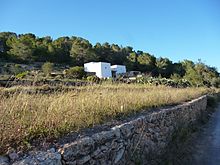
Can Frara , typical construction of an old Finca Ibicenca with stone wall in dry construction method
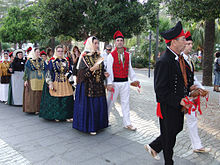
In traditional costumes with large castanets (Castanyoles)
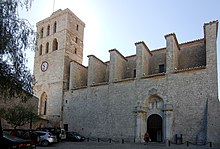
The Cathedral of Ibiza
Search within the encyclopedia